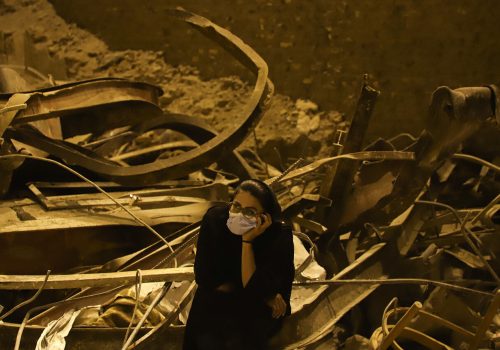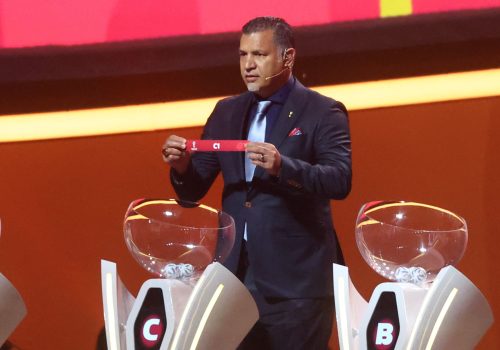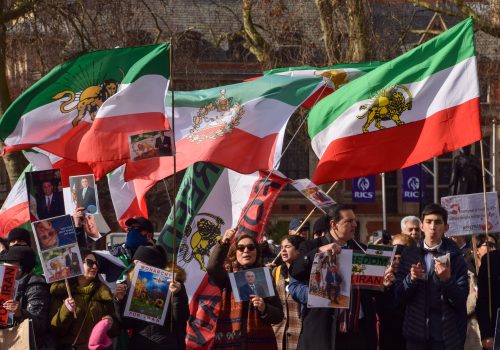March 1 is the upcoming Iranian elections. The terrain looks more divided than ever.
Iran is set to hold elections for its parliament and its Assembly of Experts, the body tasked with supervising and picking the supreme leader, on March 1. But while the elections held under the Islamic Republic have never been free or fair, the 2024 elections are the most restricted polls in decades—perhaps even in the history of the Islamic Republic.
Electoral politics in the Islamic Republic have always been limited to various wings of the ruling regime, which, since the late 1990s, has been divided into two general camps: reformists (Eslahtalabs), who supported the presidency of Mohammad Khatami (1997–2005) and advocated for varying degrees of democratization, and conservatives or principlists (Osoolgerayan) who opposed them and supported the authoritarian rule of Supreme Leader Ayatollah Ali Khamenei.
This time around, much like in the 2020 parliamentary and 2021 presidential elections—but on an even more drastic scale—the vast majority of reformists are disqualified from running, and many centrist conservatives have also not been allowed to run. While around eighty sitting members of parliament (MPs) had already been disqualified in 2020, in this election, twenty-six additional sitting MPs were barred from running. Also disqualified was the former head of the parliament’s foreign policy committee, Heshmatollah Falahatpisheh, who is known for his criticisms of Iran’s arming of Russia against Ukraine.
The disqualifications reached even more farcical proportions for the Assembly of Experts. Sitting assembly members whose candidacies were thrown out include former President Hassan Rouhani, who previously held many key military and security positions, and Mahmoud Alavi and Heydar Moslehi, both of whom are former intelligence ministers. In almost all provinces, the election result is already known. Of the 144 approved candidates, none are reformists, and only three are pro-Rouhani centrists.
This widespread disenfranchisement reflects the rule of Khamenei through the Guardian Council, the body that decides who runs in elections. Half of its twelve members are appointed directly by supreme leader, while the other half are selected by the Khamenei-appointed head of the judiciary. This important vehicle has helped Khamenei fill all institutions with only his most ardent supporters. As if this is not enough, Khamenei also keeps building parallel institutions. In recent years, a series of “high councils,” often appointed by Khamenei, have taken over many legislative functions from the parliament. At almost eighty-five years of age, the supreme leader is not getting any younger and is preparing the ground for the eventual succession crisis by leaving power in the hands of loyalists.
Not surprisingly, these super-restricted elections are expected to have historically low turnout—lower than in previous elections—with a recent official poll putting the likely national turnout at 35 percent and only 18 percent for Tehran. With widespread disillusionment with the Islamic Republic and its unrepresentative institutions, few people care to take part in these elections.
Reformists divided
Predictably, the elections have been boycotted by political organizations opposed to the Islamic Republic, such as the National Front of Iran, Left Party of Iran, and Iran Transition Council. Former political prisoner Kamal Jafari Yazdi and Gohar Eshghi, mother of a blogger who was killed under torture in 2012, issued a joint statement decrying the “sham” elections, joining dozens of other opponents who are boycotting the polls.
But the boycotts aren’t limited to the regime’s opponents. Faced with widespread disqualifications, the Iranian Reformist Front (IRF), a coalition of thirty-one reformist parties representing this political community’s leading opinion, has declared that it won’t participate in the elections. The Freedom Movement of Iran, an influential liberal Islamist party, has also declared it won’t participate in the polls.
Even the Assembly of Qom Seminary Instructors and Scholars, an association that brings together pro-reform clerics, has taken a similar position and declared that it is not backing any candidates in the elections. Saeed Hajjarian, the leading theoretician of reformists, and Abbas Abdi, among the leading reformist lights, have also said they won’t vote.
From inside the Evin prison, Mostafa Tajzadeh has joined the boycott. In a letter, the former deputy interior minister under President Mohammad Khatami accused Khamenei of lacking “political foresight and moral courage” and called for the establishment of ties with the United States, ending compulsory veiling, and holding free elections. Following the publication of the letter, Tajzadeh’s visitation and telephone rights have been curtailed, and he is now in solitary confinement.
However, not all reformists agree with the call for a boycott.
On February 12, 110 prominent Iranians issued a joint statement calling on people to participate in the elections and vote for the few reformist candidates allowed to run, as well as those who are “centrist” or “pro-development.” The call’s signatories include former Tehran Mayor Gholamhossein Karbaschi, well-known sociologists Maqsud Ferasatkhah and Hamidreza Jalayipour, and several members of former Speaker Mehdi Karroubi’s National Trust Party (NTP). While Karroubi himself has remained under house arrest since 2011 due to the 2009 post-election protests known as the Green Movement, his party has not been banned, unlike some other reformist organizations. The letter has also been supported by Mohammad Qoochani, a leading journalist historically close to Karoubi and Rouhani, who has vociferously criticized IRF for its position.
As only a few dozen reformist candidates have been allowed to run nationally—out of fifteen thousand total candidates—the signatories know that they can’t aim to win a majority. Instead, they are calling for the formation of a solid minority block of anti-hardliners in the parliament.
SIGN UP FOR THE THIS WEEK IN THE MIDEAST NEWSLETTER
Making a similar gambit is Ali Motahhari, a centrist former MP who was disqualified in 2020 but was surprisingly allowed to run this time around. Despite being nominally a conservative, Motahhari is seen as an ally of reformists due to his anti-hardliner positions. Yet, reformists also acknowledge his regressive social positions. In 2014, for instance, he caused controversy by bringing pictures of women in leggings to the parliament and expressing concern about their prevalence. Motahhari, the deputy parliament speaker from 2016 to 2019, is heading a slate called Voice of the Nation in Tehran, which will likely be backed by those reformists who decide to vote. The slate includes at least two NTP members and Mohammad Bathaei, education minister under Rouhani. Not surprisingly, the slate has been openly backed by Maziar Balayi, an NTP central council member, and Mohammad-Sadeq Javadihesar, the party’s spokesperson. It also includes conservatives such as Berkeley-educated former MP Ali Abbaspour Tehrani, who was once a leading member of the Islamic Coalition Party, a key conservative party. Backing candidates in twenty-two out of Iran’s thirty-one provinces, NTP is therefore breaking with the electoral boycott despite affirming that it continues to be a member of IRF.
Despite his being disqualified, Rouhani called on people to cast a “protest vote,” and his Moderation and Development Party (MDP) is backing Motahhari’s list in Tehran, as well as some candidates in twenty-seven out of thirty-one provinces of the country. The party’s leader, Mohammad Baqer Nobakht, a vice president under Rouhani, is also running in the northern city of Rasht, where he has a real chance of being elected as one of the city’s three MPs, who currently all belong to the leading conservative organization, Coalition Council of the Forces of the Islamic Revolution (CCFIR). This time around, conservative divisions might lead to a victory for Nobakht. Notably, he has also been endorsed by Ali Larijani, a conservative former speaker of the parliament, who issued a video in his support.
In fact, those reformists who favor participation in the election are putting much hope in the provinces, where they often have a better chance.
The pattern of elections in provinces outside Tehran is entirely different from that in the capital, as regional concerns and local issues—rather than national political divisions—often dominate the vote. Elections in provinces also usually have higher turnout. In the 2020 elections, for instance, ten out of thirty-one provinces had turnout higher than 50 percent, reaching 70.66 percent in the small Kohgiluyeh and Boyer-Ahmad province in southwestern Iran. One reason is that, even if they cannot wield much political power, MPs can fulfill a clientelist function by delivering specific projects to their province.
One province where reformists maintain some hope is the southern Kerman province. Known as the home province of slain Islamic Revolutionary Guard Corps (IRGC) commander Qasem Soleimani, the province was also home to the late Ayatollah Akbar Hashemi Rafsanjani, a powerful regime founder and a leading centrist president (1989–1997) who died suspiciously in 2017. Rafsanjani’s legacy is continued by the Executives of Construction Party (ECP), a party formed by his political associates and currently headed by Hossein Marashi, a former MP and Kerman governor and a cousin of Rafsanjani’s wife. According to Marashi, enough reformists have been allowed to run in Kerman that there is “real competition” for nine of the province’s ten seats. Currently, eight out of the ten seats belong to CCFIR, with the other two belonging to a reformist and an independent. Therefore, any advance for reformists would be notable. Marashi also said his party had helped put together Motahhari’s slate.
Northwestern Tabriz, the political capital of Iran’s Turkic ethnic minority, saw a rare case of a reformist MP topping the polls in 2020. Masoud Pezeshkian, health minister under Khatami (2001–2005) and a pro-Rouhani deputy speaker of parliament (2016–2020), is running again and will likely be a leading reformist voice in the coming Majlis. MDP, NTP, and ECP have also endorsed him.
Another reformist candidate with some hope is ECP’s Nahid Tajeddin, a former Isfahan MP (2016–2020) who was also allowed to run in 2020 but lost after coming in ninth place (the city elects five MPs). Tajeddin was initially rumored to be running in Tehran as part of Motahhari’s list, but opted to return to her hometown. With all the city’s five MPs currently belonging to CCFIR, reformists hope Tajeddin can gain enough votes in this crucial central city to return to parliament.
Hardliner domination
With the vast disqualification of reformists and centrists, many of the elections have been reduced to competitions between various conservative and hardliner factions.
In the days leading to the elections, CCFIR has had to deal with a lot of conservative infighting. It was able to declare its full slate for Tehran only on February 25, less than a week before the elections. The list will be headed by Mohammad Baqer Ghalibaf, the current speaker of the parliament. The more hardline Resistance Front (RF)ultimately agreed to running a joint slate with CCFIR, although its officials claim the front’s top figure, MP Morteza Aqatehrani, is effectively a co-head of the list and is not subordinate to Ghalibaf. But not all conservative groups have accepted working with Ghalibaf. The Unity Council of Forces of the Islamic Revolution (UCFIR), a 2020 split from CCFIR, introduced its Tehran slate without Ghalibaf. Manochehr Motakki, a former foreign minister under Mahmoud Ahmadinejad, heads it.
More consequentially, Ghalibaf is strongly contested by a new generation of hardliners who are hard at work trying to dislodge him. These efforts have intensified since a scandal broke out on February 13. As first revealed by London-based outlet Iran International, Ghalibaf’s son is known to have had his request for immigration to Canada rejected. The leaked files show him owning at least two apartments in Australia and a Tehran bank account with around $300,000 in savings.
Another recent scandal to hit CCFIR alleged that one of its Tehran MPs, Mohsen Dehnavi, received a bribe from a factory manager in exchange for helping them with a bank loan. Dehnavi previously made news in 2017 after the United States refused him entry when he tried going there for a medical postdoctoral program at Harvard. Some hardliners now wish to distance themselves from him. On February 24, Malek Shariati, a Tehran MP and head of the small hardliner party, declared that he would refuse a space on the CCFIR slate if Dehnavi were also on the ballot. A day later, Dehnavi said he was resigning from the slate so as to preserve unity. The final joint slate by CCFIR and RF includes Shariati but not Dehnavi.
However, some hardliners are putting up a more systematic challenge to Ghalibaf. Chief among them is the newly formed Dawn Front of Iran (DFI) headed by Ali Akbar Raefipour, a fiery populist best known for concocting conspiracy theories (he heads an organization dedicated to “struggle against Zionism, Humanism, and Masonry”). DFI’s other notable founding member is Saeed Mohammad, an IRGC commander who led the militia’s engineering behemoth for years.
Mohammad represents a generation of IRGC commanders who are already eyeing the post-Khamenei landscape in Iran as they plot their political future. His candidacy for president was disqualified in 2021, after which he endorsed Ebrahim Raisi. He served under Raisi for a year, then was dismissed in 2022 and has thus acquired more of an oppositional position. Former hardline MP Hamid Rasai is also heading another rival conservative list, known as the Popular Coalition of the Forces of the Islamic Republic (PCFIR), ending speculation that he, too, might unite with Raefipour.
If enough voters turn out for slates headed by Motakki, Motahhari, Rasaei, or Raefipour on opposite sides of the political spectrum, Ghalibaf might lose his spot as the top Tehran MP—which could presumably lead to him losing his position as the parliamentary speaker. But because Tehranis have little enthusiasm for these elections, this remains a very tall order. Still, if Raefipour and Mohammad manage to form a durable new faction in Iranian hardliner politics, they might go on to play a role in the tumultuous days that are sure to come in what is expected to be the Islamic Republic’s lowest-turnout election.
Arash Azizi is a writer and scholar. He is the author of “The Shadow Commander: Soleimani, the US and Iran’s Global Ambitions” and “What Iranians Want.” Follow him on X: @arash_tehran.
Further reading
Wed, Jun 8, 2022
‘From Cinema Rex to Metropol,’ Iranians have had enough
IranSource By
On May 23, a ten-story commercial tower came crashing down on people’s heads in Abadan. With each body recovered from the ruins, public anger crescendoed, leading to ongoing street protests in multiple areas in Khuzestan province and beyond.
Wed, Jan 11, 2023
Soccer players versus the IRGC. Who do the people of Iran choose?
IranSource By
Iranians know who their national heroes are.
Wed, May 10, 2023
After a failed coalition effort, where is the Iranian opposition headed?
IranSource By
Cracks within the Iranian opposition coalition were visible from the outset, with much of the division revolving around former Crown Prince Reza Pahlavi’s persona.
Image: Two Iranian schoolgirls are sitting together without wearing mandatory headscarves under two electoral posters at a bus stand in downtown Tehran, Iran, on February 26, 2024, four days before the parliamentary elections. The Iranian Parliament elections are set to be held on March 1st. (Photo by Morteza Nikoubazl/NurPhoto)


